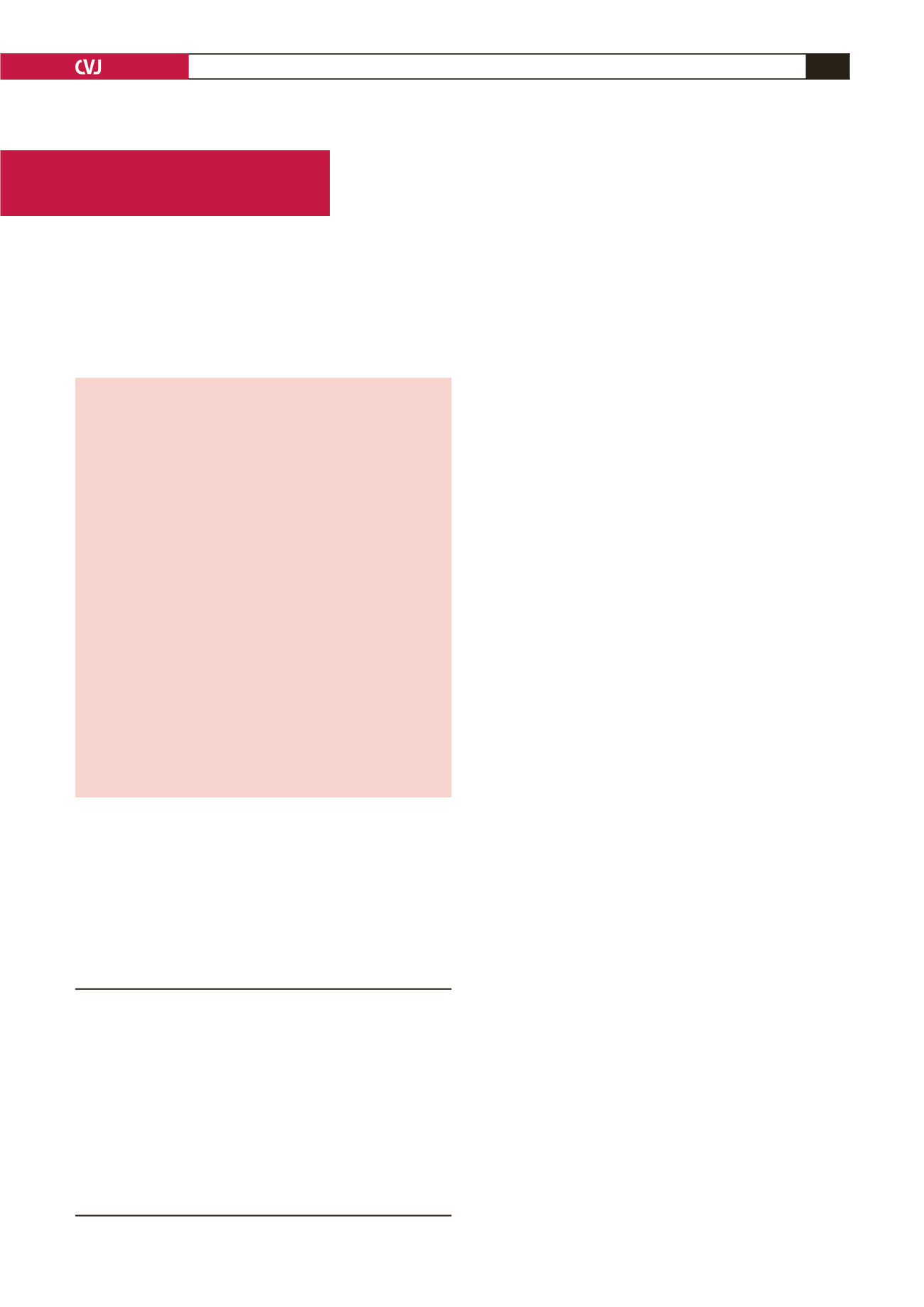

CARDIOVASCULAR JOURNAL OF AFRICA • Volume 27, No 3, May/June 2016
AFRICA
e15
Case Report
Unexpected complication of oesophagoscopy: iatrogenic
aortic injury in a child
Orhan Tezcan, Menduh Oruc, Mahir Kuyumcu, Sinan Demirtas, Celal Yavuz, Oguz Karahan
Abstract
Introduction:
Oesophagoscopy is usually a safe procedure to
localise and remove ingested foreign bodies, however, unex-
pected complications may develop during this procedure.
In this case report we discuss iatrogenic aortic injury, which
developed during oesophagoscopy, and its immediate treat-
ment.
Case report:
A six-year-old male patient was admitted to
hospital with symptoms of having ingested a foreign body.
Oesophagoscopy was carried out and the foreign body
was visualised at the second constriction of the oesoph-
agus. During this procedure, profuse bleeding occurred.
Subsequently, a balloon dilator was placed to control bleeding
in the oesophagus. Thoracic contrast tomography revealed
thoracic aortic injury. Open surgical aortic repair was imme-
diately carried out on the patient and the oesophageal hole
was primarily repaired. The patient was discharged on post-
operative day 15 with a total cure.
Conclusion:
Although oesophagoscopy is a safe, easily applied
method, it should be kept in mind that fatal complications
may occur during the procedure. This procedure should be
done in high-level medical centres, which have extra facilities
for managing complications.
Keywords:
oesophagoscopy, complication, aortic injury
Submitted 14/1/16, accepted 17/2/16
Cardiovasc J Afr
2016;
27
: e15–e17
www.cvja.co.zaDOI: 10.5830/CVJA-2016-015
Oesophagoscopy is an effective diagnostic and treatment method
for oesophageal pathologies, with 0.03 to 17%complication rates.
1,2
Perforation and bleeding are the most important complications
of this procedure. Previous reports have claimed that therapeutic
interventions with oesophagoscopy present more risks with
regard to complications, than other diagnostic procedures.
1,2
Ingestion of a foreign body into the oesophagus has serious
potential for perforation.
3
Oesophagoscopy strategies can be
used both for detecting the location of the foreign body and for
removal of it. However, it should be borne in mind that treatment
with oesophagoscopy has the potential for further aortic injury
if sufficient pre-operative evaluation of the anatomical and
pathological status is not done.
3
In this study, we present a case
of aortic injury during oesophagoscopy in a patient with foreign
body ingestion.
Case report
A six-year-old male patient was admitted to hospital with
dysphagia. Chest radiograms revealed the image of a coin at the
second constriction of the oesophagus (Fig. 1A).
Rigid oesophagoscopy was carried out on the patient under
general anaesthesia. Copious bleeding was noted during removal
of the foreign body, so flexible oesophagoscopy was used. The
injury site could not be determined due to severe haemorrhage.
Because the blood pressure was dropping rapidly (60/30 mmHg),
an achalasia balloon (polyethylene balloon) dilator (Figs 1B, 2A)
was placed in the oesophagus to control the bleeding.
The haemoglobin level was 5 g/dl and three units of erythrocyte
suspension replacement were administered immediately. After
controlling the bleeding with the balloon dilator, contrast
tomography (CT) was carried out. The coin was visualised in the
stomach during the chest radiography (Figs 1B, 2A). Contrast
extravasation revealed it near the descending aorta (crossing site
of oesophagus) (Fig. 2A, B, C).
We consulted with a cardiovascular surgeon and immediate
surgery on the descending aorta was planned. The patient
was taken to the theatre for aortic repair. A left posterolateral
thoracotomy was carried out on the patient for surgical
exploration of the descending aorta. The injured site of the
aorta was detected (Fig. 3A) and then repaired primarily with
pledgeted sutures (Fig. 3B).
Just below the damaged aorta, a 1-cm oesophageal injury was
detected. After dissection of the parietal pleura, the oesophagus
was primarily repaired to avoid development of an aorto-
oesophageal fistula. The patient was taken to the intensive care
unit after the operation.
Department of Cardiovascular Surgery, Medical School of
Dicle University, Diyarbakir, Turkey
Orhan Tezcan, MD,
dr.orhantezcan@gmail.comSinan Demirtas, MD
Celal Yavuz, MD
Department of Chest Surgery, Medical School of Dicle
University, Diyarbakir, Turkey
Menduh Oruc, MD
Oguz Karahan, MD
Department of Anesthesiology, Medical School of Dicle
University, Diyarbakir, Turkey
Mahir Kuyumcu, MD

















